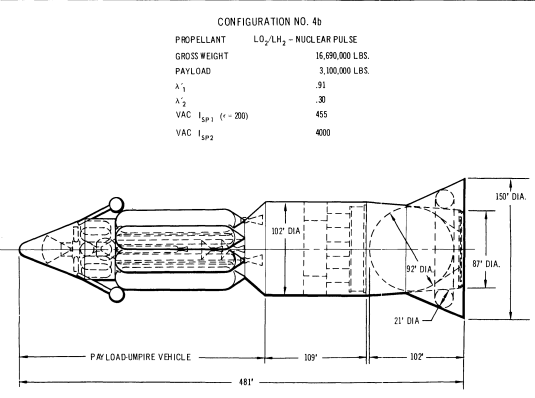Apr 082010
This comes from the recently acquired report on ROMBUS, but since it’s not strictly a ROMBUS design… here ya go. A simple design sketch of a launch vehicle that uses a relatively simple recoverable hydrogen/oxygen first stage and an Orion nuclear-pulse propulsion second stage in order to toss an UMPIRE manned Mars vehicle on its way. Nothing about this design can be considered small…
10 Responses to “Douglas Orion-based launcher, 1963”
Sorry, the comment form is closed at this time.

i don’t get it
why use Atomic puls engine only as second stage ?
Because ground launching an Orion is basically never going to happen, so you need a substantial conventional booster to loft the Orion almost out of the atmosphere before it can start operating.
A diameter half the length of a football field, 500 feet tall, and loaded with tiny A-bombs. That’s when men were men, baby.
I’ll have to find it again but I have an article on Externally Pulsed Propulsion that suggests a surface launch using “Non-Weapons”-“Super-High-Explosive” (SHE) charges as pulse cartridges.
As explained there are types of explosives that are more powerfull than ‘conventional’ explosives but have certain ‘drawbacks’ that make them unacceptable for use as weapons. Things like spontanious detonation after a few weeks of storage, etc.
However these SHE’s could be useful for such things as surface launching, manuevering, and landing an ORION type spacecraft. And it was further pointed out that the ORION need not actually CARRY any of these explosives on-board! The cartridges could be supplied via a process similar to beamed power suggested for laser or microwave launch.
Since the vehicle trajectory, speed and other data would be constantly updated and well known aiming and ‘hitting’ (actually the SHE would detonate a specified distance away) the pusher assembly on the vehicle would be far easier and more accurate for beaming assemblies already designed for defense against aircraft.
So… The ORION vehicle is initially launched using some SRBs, or a series of on-board SHE-cartridges. Once at altitude and in position the ORION adjusts the angle of its pusher plate and signals its ready.
Below on the ground a “battery” of about 10 or more high-speed 5″ guns start shooting SHE-shells in a coordinated pattern, putting a warhead on a designated position and distance from the pusher plate for maxium effect.
Each warhead is designed to give the maxium impulse with little or no damage effects to the ORION pusher plate, thrusting the ORION on to orbital speed.
Of course there would have to be multiple “batteries” along the flight path unless some form of range-extension and guidance was on-board the warheads but this would probably detract from the effectivness of the warhead.
Intesting concept but the number of guns needed is going to be up there. I’d wondered if you could build a ‘gattling’ 5″ gun-system but that would be expensive too. Hmmm, “MetalStorm” is always looking for an application for THIER system…
Randy
Michel Van:
>why use Atomic puls engine only as second stage ?
admin Says:
>so you need a substantial conventional booster
>to loft the Orion almost out of the atmosphere before it can start operating.
I know that,
It’s only why as second stage and not as main propulsion modul for the Mission ?
Found the paper:
http://ntrs.nasa.gov/archive/nasa/casi.ntrs.nasa.gov/20000097368_2000138015.pdf
Page 3 under “Earth-To-Orbit Challenge” paragraph “Advanced Chemical Explosives”
Randy
SHEs to Venus, 1974:
Title: Explosive propulsion applications
Author(s): Nakamura, Y.; Varsi, G.; Back, L. H.
Abstract: The feasibility and application of an explosive propulsion concept capable of supporting future unmanned missions in the post-1980 era were examined and recommendations made for advanced technology development tasks. The Venus large lander mission was selected as the first in which the explosive propulsion concept can find application. A conceptual design was generated and its performance, weight, costs, and interaction effects determined. Comparisons were made with conventional propulsion alternatives. The feasibility of the explosive propulsion system was verified for planetology experiments within the dense atmosphere of Venus as well as the outer planets. Additionally, it was determined that the Venus large lander mission could be augmented ballistically with a significant delivery margin.
NASA Center: Jet Propulsion Laboratory
Publication Date: Apr 1, 1974
Document Source: CASI
Online Source: http://ntrs.nasa.gov/archive/nasa/casi.ntrs.nasa.gov/19740015362_1974015362.pdf
Most of the explosives listed are pretty unimpressive from an Isp standpoint, and none come anywhere near Orion performance. Still, there’s an interesting and useful table at the back. Thanks for the link.
Saving the orion for an upper stages helps in several ways. It is most important to reduce fallout on the ground, this is the largest political barrier (but not the last) to an Orion spacecraft. But also, the gets rid of the need for high thrust, and prevents the risk of disaster if one or two bombs misfire. It is possible that blast shock from atmospheric charges would increase ISP, but it is also possible that this blast shock could cause damage to the spacecraft, or demand that the airframe be very heavy, more so than in space.
The real question is – will such a small Orion stage have a particularly good ISP or mass fraction? Probably not. But you have to start somewhere.
[…] a stable mate of this concept. A somewhat simplistic design for a two-stage booster utilizing a conventional hydrogen/oxygen […]